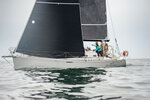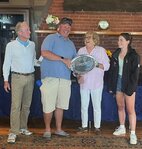




The 56th running of the S.S. Crocker Memorial Race took place on Saturday, July 8, a day that began with no wind and poor prospects for the competitors. But it ended as a wonderful example of the sport of sailboat racing, offering varied and challenging conditions, and followed by a great party and a delightful outcome at the awards ceremony.
The overall winner in the competitive fleet was a racing boat designed over 100 years ago, which started in 11th place, and came out on top.
The Crocker Race is a “pursuit race” in which smaller and slower boats start earlier, with times determined by the handicap system, while the bigger and faster boats start later so that, in theory, all the boats arrive at the finish line at the same time. This annual race is a collaboration of Crocker’s Boat Yard, the Manchester Harbor Boat Club, and the Manchester Yacht Club. The 12.3-mile course is a simple triangle beginning and ending at the Gales Ledge nun buoy off House Island. The course takes the fleet around the Eastern Point bell buoy off Gloucester and the Newcomb’s Ledge Whistle at the outer end of the Salem Ship Channel. The Race Committee can send the fleet either clockwise to Gloucester and then to Newcomb’s to return to the starting point, or counterclockwise from Gales Ledge to Newcomb’s, then up to Gloucester, and returning to Gales.
The weather forecast was for light winds of 6 to 8 mph from the southeast for most of the day, but the committee boat arrived at the starting area to find the wind light from the northeast with an annoying, lumpy sea. But just before the scheduled start, the wind steadied and gradually strengthened from the northeast, and the Race Committee signaled for the first leg towards Eastern Point. The “Warning Gun”, fired off at 10:45 a.m., was followed three minutes later by the start of the smallest boat in the fleet, an Ensign of only 19 feet. For the next hour, each boat received its individual start time and by 11:40 a.m. everyone had crossed the start line and was heading to Eastern Point in the building breeze.
Leaving the starting line, the racers were beating into the strong incoming tide, sweeping down Cape Ann towards Manchester. The skippers were faced with a tactical decision: should they stay on starboard tack, heading in towards shore and some relief from the tide; or should they take port tack out to open water, hopefully finding more wind offshore, even if they had more adverse current. As the racers moved up the 4.5-mile first leg towards the Eastern Point buoy, it appeared that going inshore paid off. Luke Buxton in his small Star boat only 23-feet-long, worked the left side of the course closer to shore, and seemed to gain a significant edge. When he rounded the Eastern Point buoy at 12:32, they were over six minutes ahead of the next boat, Peter Engle’s Goldeneye, a 37-foot Jenneau from Marblehead. After rounding the Eastern Point buoy, the sailors headed off on a broad reach on the port jibe towards Newcomb’s Ledge. At this point, the 21 boats in the ‘Racing Division’, were able to put up their spinnakers and double their existing sail area, increasing their speed dramatically on the 5-mile leg.
Shortly after the leading boats rounded Eastern Point and set spinnakers, a light fog rolled in, so that the shoreline, and more importantly, the buoy at Newcomb’s became invisible. At this point, the sailors were forced to rely on their navigation systems showing a chart of the area and the compass headings to locate and round the marks of the course. Luckily, the fog lifted after only a few minutes, and all the competitors, as well as the shoreline, were visible once more.
On the committee boat we headed back to the starting area at Gales Ledge, to anchor and tally the fleet of 34 boats across the finish line. However, the fog re-appeared, but this time much thicker, and we could no longer see the shoreline, the Gales Ledge red nun, or even the finish mark which was only 50 yards away!
Upon reaching the Newcomb’s Ledge buoy, the racers needed to jibe from port onto starboard, and sheet in their spinnakers for the 2.5-mile close reach to the finish near Gales Ledge. For those of us on the committee boat, after a short wait, the first boat emerged from the fog, heading straight for the center of the finish line. It was Buxton’s Star boat, moving easily on a beam reach driven at hull speed by its large mainsail. He was quickly followed by Sparkle Pony, Bill Finn’s 37-footer from Boston, then Virgo, a Salona 33 from Beverly, and Goldeneye. The rest of the fleet made it to the finish line over the next hour and a half.
Asked after the race what he attributed to his position at the top of the fleet, Buxton said, “The Star was designed in 1910 for the light airs of Long Island sound, so the conditions were very favorable for us on Saturday. The fog made it challenging on the last leg, and we were happy to have the Navionics app on my phone to help us find our way to the finish line. For me, the best part about winning the race was sailing with my daughter Evelyn.”
While Buxton made it seem like the boat did all the work, one could see that he also had the boat moving very well in the light and difficult conditions and made good tactical choices on the first upwind leg, taking account of the wind and the currents. Furthermore, he kept up his speed on the downwind legs without having a spinnaker and brought his vessel straight in to the finish line in the “pea soup” fog.
The organizers put on a great post-race party on the deck of the MYC with some phenomenal food and a quick-pouring bar. Most of the revelers were packed into the Club Room for the awards ceremony which was very well attended (perhaps because someone shut down the bar to get people’s attention). Kitty Crocker Palmer, a descendant of S.S. Crocker, spoke about her grandfather and his love of building beautiful sailing boats. She then awarded the eighteen beautiful trophies from Mariposa to the top three finishers in each of the six classes. But the loudest applause was when she presented Luke and Evelyn Buxton with the trophy for “First Overall”.